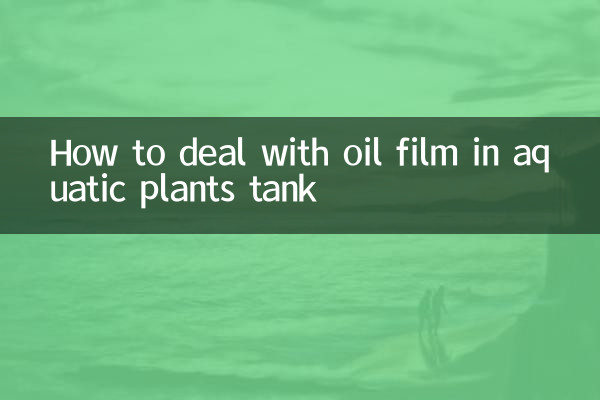How to deal with oil film in aquatic plants tank
Oil film in aquatic plants is a common problem encountered by many aquarium enthusiasts. It not only affects the appearance, but may also pose a threat to the health of aquatic plants and fish. This article will combine the hot topics and hot content on the Internet in the past 10 days to provide you with a detailed analysis of the causes, hazards and treatment methods of oil film in aquatic plants, and provide structured data for your reference.
1. Causes of oil film in aquatic plants tank

The formation of oil film is usually caused by the following reasons:
| Cause | illustrate |
|---|---|
| Feed residue | Excess feed breaks down in the water, releasing oil. |
| fish excrement | Accumulation of organic matter produced by fish metabolism. |
| Rotting of aquatic plants | Decaying aquatic plant blades release oils. |
| water quality issues | An imbalance of microorganisms in the water prevents oils from breaking down. |
2. The harm of oil film in aquatic plants tank
The oil film not only affects the viewing quality, but may also cause the following problems:
| harm | Influence |
|---|---|
| hypoxia | The oil film blocks oxygen exchange, causing fish to become hypoxic. |
| Water quality deteriorates | Oil accumulation can breed harmful bacteria. |
| Limited growth of aquatic plants | The oil film blocks light and affects photosynthesis of aquatic plants. |
3. How to deal with oil film in aquatic plants tank
The following are the most popular oil film treatment methods on the Internet in the past 10 days:
| method | Operation steps | Advantages and Disadvantages |
|---|---|---|
| physical removal | Use an oil film processor or oil-absorbing paper to absorb the oil film. | Quick and effective, but requires regular operation. |
| biological control | Raise oily fish (such as guppies, Mary fish). | Ecological and environmentally friendly, but the effect is slow. |
| water quality adjustment | Increase the frequency of water changes and add nitrifying bacteria. | It is a fundamental solution, but it needs to be adhered to for a long time. |
| Filtration system optimization | Install an oil removal membrane or upgrade the filtration system. | Once and for all, but the cost is higher. |
4. Hot Topics: New Trends in Oil Film Treatment
According to online discussions in the past 10 days, the following oil film treatment methods have attracted much attention:
1.Nanobubble technology: Decomposes the oil film by releasing tiny bubbles, the effect is remarkable but the equipment is expensive.
2.plant extracts: Certain aquatic plants (such as duckweed) can absorb oil, which is environmentally friendly and beautiful.
3.Intelligent monitoring system: Monitor the oil film thickness in real time through the sensor and automatically start the processing program.
5. Tips to prevent oil film
1. Control the amount of feeding to avoid feed residue.
2. Regularly clean up remaining aquatic plant leaves and fish excrement.
3. Keep water quality stable and regularly detect pH value and ammonia nitrogen content.
4. Properly mix fish to avoid over-feeding.
6. Summary
The treatment of oil film in aquatic plants requires a combination of multiple methods, and the most suitable solution is selected according to the actual situation. Physical removal is fast and effective, biological control is ecological and environmentally friendly, water quality adjustment is a fundamental solution, and filtration system optimization can solve the problem once and for all. Paying attention to emerging technologies, such as nanobubbles and smart monitoring, can also bring a better experience to your fish tank.
Through the above methods, you can easily solve the oil film problem in your aquatic plant tank and keep your fish tank clear and beautiful!

check the details

check the details